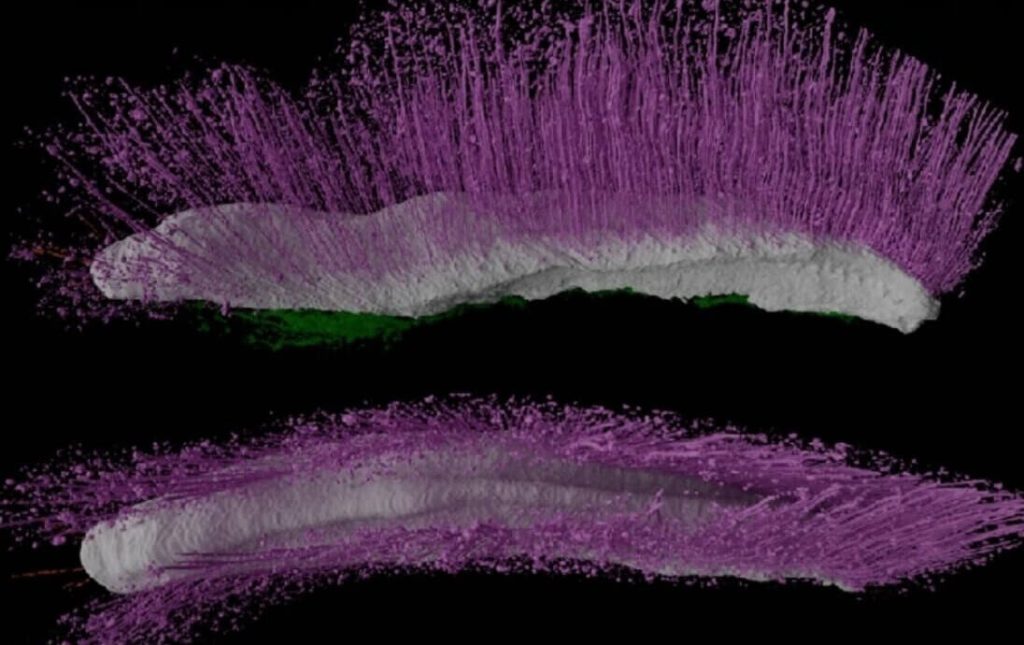

Holotype of Punk ferox (Credit: Oxford University Museum of Natural History)
Meet Earth’s first punk rockers: Ancient sea creatures sported mohawk-like spines
LONDON — When scientists discovered two ancient sea creatures from 430 million years ago, they didn’t expect to find themselves drawing parallels with punk rock fashion. Yet these spiky fossils, unearthed in England, bore such a striking resemblance to punk rock aesthetics that their nicknames stuck, eventually becoming their official scientific names. In the process, they revolutionized our understanding of early animal evolution.
In this remarkable case of science meeting counterculture, an international study published in Nature takes a closer look at these two ancient sea creatures. Their appearances were so reminiscent of the spiky hairstyles we see in punk rock fashion that scientists couldn’t resist naming them accordingly.
“The names Punk and Emo were actually our initial pet names for these ancient mollusks, inspired by some of their unique features and individuality,” says lead study author Dr. Mark Sutton from Imperial College London, in a statement. “Punk in particular, with its spiky appearance, clearly resembles a rebellious punk rocker – and we thought Emo complemented it well.”
But these fossils, formally named Punk ferox and Emo vorticaudum, represent much more than clever nomenclature. They belong to an ancient group called Aculifera, distant relatives of today’s chitons, oval-shaped marine animals that cling to rocks with shells resembling medieval armor.


“Mollusks are one of the largest and most diverse animal groups on Earth,” notes Dr. Sutton. “However, early Aculiferan mollusks are much less well-known than some of their relatives. We have limited information about this group, and for a very long time, we assumed they were rather basic, simple, and primitive.”
These new discoveries shatter that assumption. The researchers employed two sophisticated imaging techniques to study the fossils in unprecedented detail. First, they used powerful X-ray scanning to examine internal structures without damaging the specimens. Then, they methodically ground down the fossils in microscopic layers, photographing each new surface to create detailed 3D reconstructions of their external features.
“Retrieving fossils that are so exceptionally well preserved and reveal details of the soft tissues is extremely rare,” adds Dr. Sutton. “We have been able to create ‘virtual fossils’ – 3D digital models – providing us with a gold mine of information.”
These digital reconstructions reveal fascinating details about how these ancient creatures lived and moved. Both had smooth undersides, suggesting they dwelled on the seafloor. Emo vorticaudum, preserved in a distinctly folded posture, appears to have moved like an inchworm, using its spines to grip and push forward; a movement strategy never before seen in mollusks. Meanwhile, Punk ferox presents its own mysteries with a unique ridge-like foot structure unlike anything in modern mollusks.


The creatures display an unexpected mix of features. Punk ferox, while resembling worm-like mollusks with its array of long spines, also possessed a broad foot and gills similar to modern chitons. Emo vorticaudum combined a worm-like body and spines with shell plates and a compressed body reminiscent of chitons.
These ancient sea creatures may have vanished from Earth’s oceans hundreds of millions of years ago, but their discovery has permanently altered our understanding of early animal evolution. These spiky pioneers show us that innovation and experimentation in body design aren’t unique to modern times — nature was breaking conventional rules long before punk rock came along.
Paper Summary
Methodology
The research team used an innovative two-step approach to study these ancient creatures. The first step involved synchrotron X-ray microtomography – essentially a super-powered version of medical CT scanning – which allowed them to see internal structures without damaging the fossils. The second step, called physical-optical tomography, involved carefully grinding away the fossil in 20-micrometer intervals (thinner than a human hair) and photographing each new surface. These thousands of images were then combined to create detailed 3D models of the animals.
Results
The study revealed that early aculiferan mollusks possessed unexpected combinations of features and movement strategies. Both creatures showed smooth undersides for seafloor living, but each had unique locomotion methods. Emo vorticaudum’s preserved folded posture suggests an inchworm-like movement, while Punk ferox’s ridge-like foot structure indicates a novel form of locomotion unlike any modern mollusk. The findings demonstrate that early mollusks were far more diverse and complex than previously thought.
Limitations
The study examines single specimens of each species, which limits understanding of variation within these species. While the preservation is exceptional, showing soft tissue details rarely seen in fossils this old, some aspects of the animals’ anatomy and behavior must be interpreted based on comparative analysis with known species.
Discussion and Takeaways
The research fundamentally changes our understanding of early mollusk evolution. Instead of a simple progression from primitive to complex forms, these fossils show that early mollusks were already experimenting with sophisticated body plans and movement strategies. The study suggests that many characteristics thought to define major mollusk groups may have evolved multiple times independently.
Funding and Disclosures
This international collaboration involved researchers from Imperial College London, University of Leicester, University of Oxford, Senckenberg Research Institute and Natural History Museum Frankfurt, and Yale University. The research received support from multiple institutions including the Senckenberg Ocean Species Alliance, Yale Peabody Museum, The Leverhulme Trust, The Natural Environment Research Council, Oxford University Museum of Natural History, and English Nature.
Publication Information
The study, “New Silurian aculiferan fossils reveal complex early history of Mollusca,” was published in Nature, Volume 637, on January 16, 2025. The fossils are now housed in the Oxford University Museum of Natural History.







